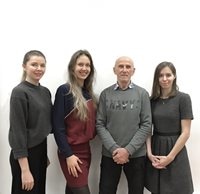Feb 20 2019
Colorful artwork can be created on metals using a range of laser-based techniques However, each technique usually needs a different type of laser and extremely specific settings.
 The research team included Lutoshina Daria, Galina Odintsova, V.P. Veiko, and Nadezhda Shchedrina. (Image credit: Nadezhda Shchedrina, ITMO University in Russia)
The research team included Lutoshina Daria, Galina Odintsova, V.P. Veiko, and Nadezhda Shchedrina. (Image credit: Nadezhda Shchedrina, ITMO University in Russia)
As part of a new research, scientists explain how to use a single commercially available laser to attain three techniques for laser colorization on metal, rendering the approaches to be more practical for a broad variety of applications in art and jewelry making, with the option of mass production.
By changing the laser processing parameters, we control the heating of the metal surface in the temperature range from the melting point to boiling and above. After laser processing, various micro and nanostructures are formed, which create optical effects that change the color of the treated surface.
Nadezhda Shchedrina, Research Team Member, ITMO University, Russia
The research team is led by Galina Odintsova from ITMO University.
In the Optical Materials Express journal, the investigators describe straightforward and reliable techniques for using a laser that releases light pulses of nanosecond duration to produce a large palette of colors on metal. The methods do not consume time excessively and can be used to form small or large images.
Our results enable a novel type of art and design. We want to introduce the laser as a technique for effective artistic expression that offers new possibilities for artists.
Yaroslava Andreeva, Research Team Member, ITMO University, Russia.
Colorful Techniques
The scientists applied three techniques—laser oxidation, laser nanoparticle formation, and laser structuring—for manipulating metal coloration with lasers. They made a color palette on the basis of their new methods and intend to expand it in due course.
For laser oxidation, the scientists describe the way to form a thin oxide film using laser on the metal surface that produces color as a result of light interference taking place in the film. This can produce color across a broad region of the metal’s surface.
The scientists also delineate the second technique, which involves using a laser to create subwavelength nanoparticles of about 5–50 nm on metal. When ambient light strikes these nanoparticles, it produces colors through an optical phenomenon called surface plasmon resonance. By varying the size and shape of the nanoparticles, the color can be changed. This technique is helpful for applying color to precious metals like silver without requiring any special sample preparation.
In the third technique for laser structuring, a laser is used to partially melt the metal surface to create a pattern of fine parallel grooves or slits called a periodic grating. The light that gets scattered from these structures results in colors depending on the observation angle. This method can be used to produce many images on the same metal surface and each image can be viewed only at a specific angle, making it applicable for protection against falsification of metal products.
Making Art with Lasers
The scientists used their new techniques to create a range of artwork. With laser oxidation, they recreated a color magazine demonstration on titanium. They also created silver jewelry with colored laser decoration to illustrate the use of nanoparticles and used laser structuring on stainless steel to form images that changed appearance and color when viewed from various angles.
These methods offer a wide variety of ways to implement ideas in jewelry or other types of metal artwork without using any consumable or toxic chemicals.
Lutoshina Daria, ITMO University, Russia.
Daria is a member of Odintsova’s research team. V.P. Veiko, who developed the concept for this project, added that it is possible to expand the color palette by forming a surface with nanoparticles composed of various metals.
The scientists state that the laser oxidation and structuring techniques are adequately reliable to be used for mass production as well as for producing individual artworks. They continue to advance the nanoparticle approach to make it more steady for daily use. Furthermore, the investigators are working to increase the number of metals to which the techniques are applicable.